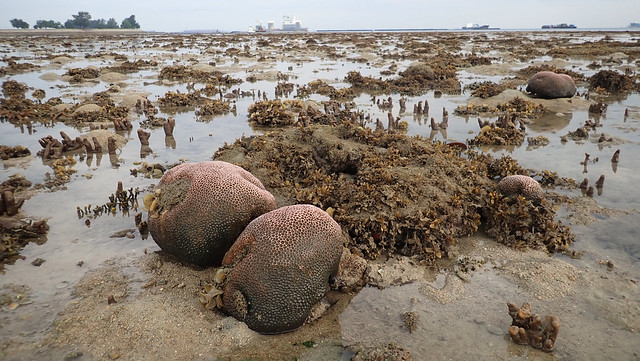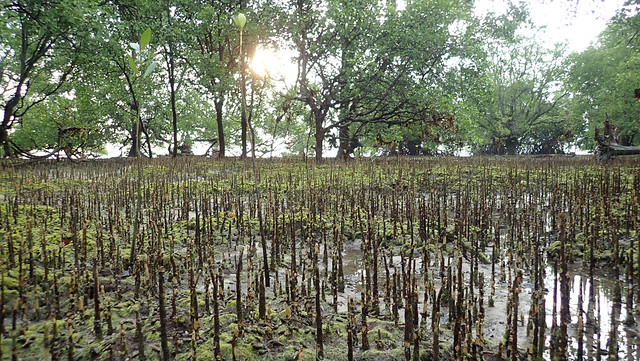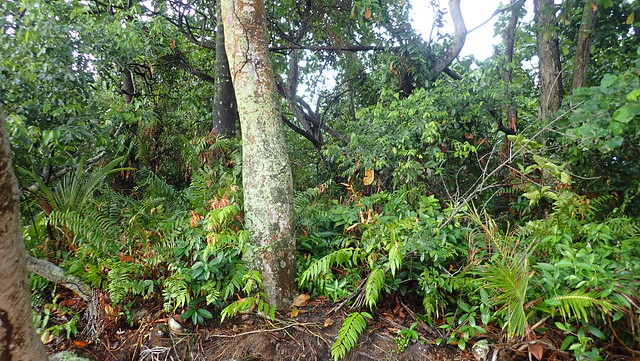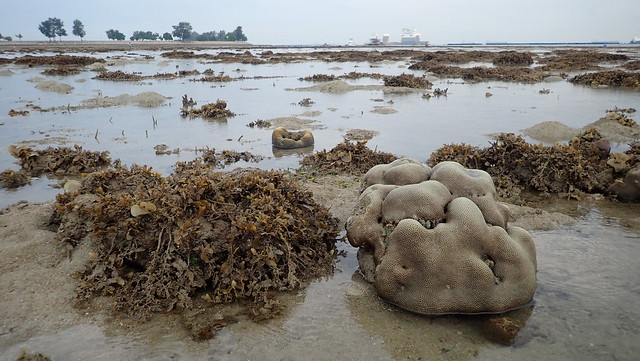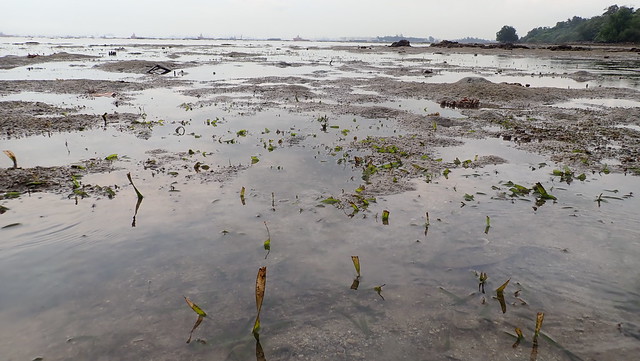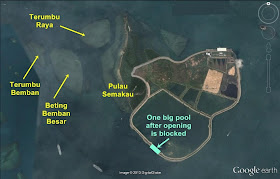I noticed some signs of bleaching and stress among the corals. I also had a quick look through the mangroves and revisited some rare trees there.
The mangroves seem to be doing well.
So nice to see the lovely Tengar putih tree is still doing well, flowering and producing propagules and still having a pretty form.
It was Dr John Yong who pointed out this Pink-eyed pong pong tree (Critically Endangered) on our last trip here nearly ten years ago! The trees are still there but precariously leaning over.
There is now a great deal of undergrowth at the highwater line. So I couldn't check for the Seashore bat lily that used to grow here.
Alas, there were large trash in the mangroves including a long thick rope draped around several trees, one crab trap through which mangrove tree roots have grown. And a very sad situation of an entire tyre around a large tree.
I briefly checked on the reefs. Many of the large coral colonies were pale or had pinkish portions (a sign of stress). This is similar to what I saw on Pulau Semakau (East) in July 2018.
I saw one very pale Acropora coral, another that was half dead, and yet another completely dead, probably recently as the build up of stuff on it still light. On our last survey in Apr 2018, I did see some pinkish Acropora coral.
I saw many of these large Merulinid corals were pink, one that was very pale and a few smaller ones that were alright.
But many other branching corals seemed alright (Branching Montipora corals, Cauliflower corals), although some Pore corals were rather pale and brightly coloured. I didn't see any Sandpaper corals.
I saw many other Merulinid corals that were alright, and one small Anemone coral that was also alright. I didn't really go into the reefy area and didn't see any other kinds of corals on this trip.
I saw one very pale Giant carpet anemone, but many others that were alright. The rest of the team found anemonefishes in them. I also saw one pale Haddon's carpet anemone, but others that were alright.
There were a wide variety of sponges.
The most amazing find for me was this humungous sea cucumber. I think it's Hermann's sea cucumber.
There were many Common sea stars, some of them in 'mating' position. Other signs of reproduction included large Moon snail collars (egg masses). I also saw many small upside down jellyfish.
We arrived after a heavy downpour so the water was murky and it was hard to check on the seagrasses. I still saw Tape seagrasses that were cropped short. The situation was not very different from what I saw in Apr 2018.
There were some patches of various kinds of seagrasses including lots of Spoon seagrass (small leaf blades), Needle seagrass, Sickle seagrass and some Noodle seagrass. But large areas of seagrass appear to be covered in epiphytes.
Very close to the Pulau Semakau Southern shore that we surveyed today is a fish farm which is said to be the largest fish farm in Singapore. We have noticed many disturbing impacts of this fish farm on the natural shores of Pulau Semakau, see the post after our trip on Aug 2014. Fortunately, on this trip we didn't see any burning of trash on the barge. We also didn't see any freshly laid fish nets on the shore either. On the way to our landing point, we did have a look the barge. There was a large bunch of netting hanging over the edge out of sight of the land. It smelled bad, we could smell it from the boat.
More about Pulau Semakau
Just as Changi Airport and Changi Beach are not the same even though they are near one another and share a name, Pulau Semakau is NOT the same as the Semakau Landfill. The Landfill was created by destroying all of Pulau Saking, and about half of the original Pulau Semakau by building a very long seawall. Fortunately, the landfill was constructed and is managed in such a way that the original mangroves, seagrass meadows and reefs on Pulau Semakau were allowed to remain.

As the existing half of the Landfill was used up, the Phase 2 of the Landfill was launched. This involved closing the gap of the seawall on the Semakau Landfill, forming one big pool where incinerated ash will be dumped. NEA worked to limit the damage to natural shoresduring the construction work for this expansion of the landfill.
The 2030 Landuse Plan by the Ministry of National Developmentreleased in Jan 2013 shows plans for 'possible future reclamation' (in light blue surrounded by dotted lines) that may impact the eastern shore of Pulau Semakau. More about the possible impact of the 2030 Landuse Plan on our shores.
The Singapore Blue Plan 2018
Pulau Semakau and nearby islands and submerged reefs have been recommended by the Singapore Blue Plan 2018 for Immediate Conservation Priority.
The Blue Plan recommends the intertidal and subtidal marine areas of Pulau Semakau and adjacent Pulau Hantu, and Pulau Jong to be designated Marine Reserve.
The Blue Plan highlights that Pulau Semakau and its associated patch reefs comprise many ecosystems: coral reefs, mangrove areas, intertidal sandflats, seagrass meadows, and coral reefs. The subtidal area of Pulau Jong is larger than the terrestrial area. Pulau Hantu is a popular dive site has seen increasing interest in the past decade due to biodiversity awareness. If protection is accorded to these three islands, zonation plans for use can be implemented to manage tourism and human impacts.
DOWNLOAD the Plan, SUPPORT the Plan! More on the Singapore Blue Plan 2018 site.
Photos by others on this trip
Richard Kuah
Chong SiewMen
Jianlin Liu
Marcus Ng
Abigail Leong
Juria Toramae
Sunny Tan
Others on this trip: Anya, Lim Yaohui.

